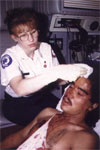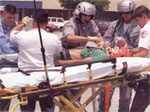|
|
||
| Home
History Facts Links Contact Us |
EMS—Man Helping MankindThe EMS system is a large, complex network of people, vehicles, specialized equipment, and facilities that is organized to respond to emergency medical situations of all types. |
|
|
Napoleon Bonaparte was the first to use an organized medical assistance program during wartime. He created non-combatant positions in his army and staffed these positions with persons whose sole responsibility was rescuing and removing men injured in battle. There was very little available in "advanced" medical care. Injuries and symptoms were treated and everyone hoped for the best. By the end of the American Civil War, advancements had been made in treating trauma cases, but medicines to treat infection were still in the future. World Wars I and II both helped advance the store of knowledge and treatment of traumatically injured persons. Advances in trauma surgery were made during the Korean and Vietnam Wars. In the early 1900s, ambulance rides were merely fast taxi rides to the nearest hospital or doctor's office. Ambulances carried no bandages, oxygen, or other medical equipment. No field assessment of the patient was made. The emergency response personnel of that day followed the "load and go" method of delivering their care. Until the concept arose that non-physicians could be trained to provide some kind of emergency care, the majority of the pre-hospital care was merely transportation provided by the local mortuaries. Victim's were often driven to the hospital in a hearse with no one in the "patient compartment" except the patient and perhaps a family member. In the mid 1950s, J.D. "Deke" Farrington, MD, FACS (known as the father of modern EMS), and others questioned why the lessons learned by the military medical corps during World War II and the Korean and Vietnam Wars could not be brought into the civilian community to improve the standard of civilian care. At that time, emergency medicine was not what we it know today. Most of the U.S. hospitals did not have a place to manage emergencies. Some hospitals had space set up at the back of the hospital which was designated as an "emergency room," however it was left unstaffed. The "ambulance driver" bringing in a patient would have to ring the doorbell beside the emergency room door so that someone from the nursing staff could come down from the ward to let them into the building. After the nurse assessed the patient, she would call a physician from home if she thought the patient was really sick or injured. Today, EMS treats and transports approximately 25 to 30 million patients per year. Use of modern emergency equipment and medications, and other pre-hospital interventions often positively affect the outcome of the patient's condition. In America, EMS personnel are highly skilled, licensed individuals who provide state-of-the-art services for anyone in need of pre-hospital emergency treatment for a wide variety of problems including everything from beestings, to major trauma from accidental injury, to medical emergencies such as heart attack and stroke. (Images courtesy of Clayton Anstis, NREMT-P) |
 |
|
 |
||
 |
||
 |
||
Home | History | Facts | Links | Contact Us |
More | |
